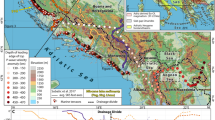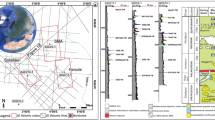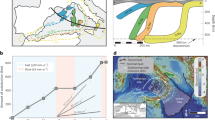Abstract
Sedimentary basins in the North Atlantic Ocean preserve a record of intermittent uplift during Cenozoic times1. These variations in elevation are thought to result from temperature changes within the underlying Icelandic mantle plume2. When parts of the European continental shelf were episodically lifted above sea level, new landscapes were carved by erosion, but these landscapes then subsided and were buried beneath marine sediments3. Here, we use three-dimensional seismic data to reconstruct one of these ancient landscapes that formed off the northwest coast of Europe during the Palaeocene–Eocene Thermal Maximum. We identify a drainage network within the landscape and, by modelling the profiles of individual rivers within this network, we reconstruct the history of surface uplift. We show that the landscape was lifted above sea level in a series of three discrete steps of 200–400 m each. After about 1 million years of subaerial exposure, this landscape was reburied. We use the magnitude and duration of uplift to constrain the temperature and velocity of a mantle-plume anomaly that drove landscape formation. We conclude that pulses of hot, chemically depleted, mantle material spread out radially beneath the lithospheric plate at velocities of ∼35 cm yr−1.
This is a preview of subscription content, access via your institution
Access options
Subscribe to this journal
Receive 12 print issues and online access
$259.00 per year
only $21.58 per issue
Buy this article
- Purchase on Springer Link
- Instant access to full article PDF
Prices may be subject to local taxes which are calculated during checkout





Similar content being viewed by others
References
Jones, S. M. & White, N. Shape and size of the starting Iceland plume swell. Earth Planet. Sci. Lett. 216, 271–282 (2003).
Shaw Champion, M. E., White, N. J., Jones, S. M. & Lovell, J. P. B. Quantifying transient mantle convective uplift: An example from the Faroe–Shetland basin. Tectonics 27, TC1002 (2008).
Smallwood, J. R. & Gill, C. E. The rise and fall of the Faroe–Shetland Basin: Evidence from seismic mapping of the Balder Formation. J. Geol. Soc. Lond. 159, 627–630 (2002).
Bijwaard, H. & Spakman, W. Tomographic evidence for a narrow whole mantle plume below Iceland. Earth Planet. Sci. Lett. 166, 121–126 (1999).
Ritsema, J., Deuss, A., van Heijst, H. J. & Woodhouse, J. H. S40RTS: A degree-40 shear-velocity model for the mantle from new Rayleigh wave dispersion, teleseismic traveltime and normal-mode splitting function measurements. Geophys. J. Int. 184, 1223–1236 (2010).
White, R. & McKenzie, D. Magmatism at rift zones: The generation of volcanic continental margins and flood basalts. J. Geophys. Res. 94, 7685–7729 (1989).
Poore, H. R., White, N. & Jones, S. A Neogene chronology of Iceland plume activity from V-shaped ridges. Earth Planet. Sci. Lett. 283, 1–13 (2009).
Mudge, D. C. & Jones, S. M. Palaeocene uplift and subsidence events in the Scotland–Shetland and North Sea region and their relationship to the Iceland Plume. J. Geol. Soc. Lond. 161, 381–386 (2004).
Mudge, D. C. & Bujak, J. P. Biostratigraphic evidence for evolving palaeoenvironments in the Lower Paleogene of the Faroe–Shetland Basin. Mar. Petrol. Geol. 18, 577–590 (2001).
Miller, K. G. et al. The Phanerozoic record of global sea-level change. Science 310, 1293–1298 (2005).
Tarboton, D. G., Bras, R. L. & Rodriguez-Iturbe, I. On the extraction of channel networks from digital elevation data. Hydrol. Process. 5, 81–100 (1991).
Pritchard, D., Roberts, G. G., White, N. J. & Richardson, C. N. Uplift histories from river profiles. Geophys. Res. Lett. 36, L24301 (2009).
Roberts, G. G. & White, N. Estimating uplift rate histories from river profiles using African examples. J. Geophys. Res. 115, B02406 (2010).
Howard, A. D. & Kerby, G. Channel changes in badlands. Geol. Soc. Am. Bull. 94, 739–752 (1983).
Yair, A., Goldberg, P. & Brimer, B. Long term denudation rates in the Zin-Havrim badlands, northern Negev, Israel. Badland Geomorphol. Piping 279–291 (1982).
Dadson, S. J. et al. Links between erosion, runoff variability and seismicity in the Taiwan orogen. Nature 426, 648–651 (2003).
Nadin, P. A., Kusnir, N. J. & Cheadle, M. J. Early Tertiary plume uplift of the North Sea and Faeroe–Shetland Basins. Earth Planet. Sci. Lett. 148, 109–127 (1997).
Underhill, J. R. Controls on the genesis and prospectivity of Paleogene palaeogeomorphic traps, East Shetland Platform, UK North Sea. Mar. Petrol. Geol. 18, 259–281 (2001).
Rudge, J. F., Shaw Champion, M. E., White, N., McKenzie, D. & Lovell, B. A plume model of transient diachronous uplift at the Earth’s surface. Earth Planet. Sci. Lett. 267, 146–160 (2008).
Ito, G. Reykjanes ‘V’-shaped ridges originating from a pulsing and dehydrating mantle plume. Nature 411, 81–684 (2001).
Hauri, E. H., Whitehead, J. A. & Hart, S. R. Fluid dynamic and geochemical aspects of entrainment in mantle plumes. J. Geophys. Res. 99, 24275–24300 (1994).
Schubert, G., Olson, P., Anderson, C. & Goldman, P. Solitary waves in mantle plumes. J. Geophys. Res. 94, 9523–9532 (1989).
Srivastava, S. P. & Tapscott, C. R. Plate kinematics of the North Atlantic. Geol. North Am. 379–404 (1986).
Lawver, L. A. & Müller, R. D. Iceland hotspot track. Geology 22, 311–314 (1994).
Delorey, A. A., Dunn, R. A. & Gaherty, J. B. Surface wave tomography of the upper mantle beneath the Reykjanes Ridge with implications for ridge–hot spot interaction. J. Geophys. Res. 112, B08313 (2007).
Acknowledgements
This research is funded by the BP–Cambridge margins project. We are grateful to R. Corfield, I. Frame, B. Lovell, D. Lyness, L. Mackay and J. Rudge for their help. M. Gurnis and R. Westaway provided reviews. Figures were prepared using the GMT, InkScape and ArcGIS software packages. Department of Earth Sciences Contribution Number esc.2064.
Author information
Authors and Affiliations
Contributions
This project was planned by N.W. Seismic mapping and drainage analysis was carried out by R.A.H. and G.G.R. Convective modelling was carried out by R.A.H. and C.R. The paper was written by N.W. and R.A.H. and the figures were drafted by G.G.R. and R.A.H.
Corresponding author
Ethics declarations
Competing interests
The authors declare no competing financial interests.
Supplementary information
Supplementary Information
Supplementary Information (PDF 144 kb)
Rights and permissions
About this article
Cite this article
Hartley, R., Roberts, G., White, N. et al. Transient convective uplift of an ancient buried landscape. Nature Geosci 4, 562–565 (2011). https://doi.org/10.1038/ngeo1191
Received:
Accepted:
Published:
Issue Date:
DOI: https://doi.org/10.1038/ngeo1191
This article is cited by
-
Influence of reef isostasy, dynamic topography, and glacial isostatic adjustment on sea-level records in Northeastern Australia
Communications Earth & Environment (2023)
-
Caribbean plate tilted and actively dragged eastwards by low-viscosity asthenospheric flow
Nature Communications (2021)
-
Paleocene-Eocene volcanic segmentation of the Norwegian-Greenland seaway reorganized high-latitude ocean circulation
Communications Earth & Environment (2021)
-
Discovery of flat seismic reflections in the mantle beneath the young Juan de Fuca Plate
Nature Communications (2020)
-
Transient mantle cooling linked to regional volcanic shut-down and early rifting in the North Atlantic Igneous Province
Bulletin of Volcanology (2020)



